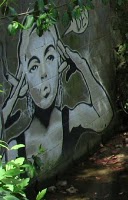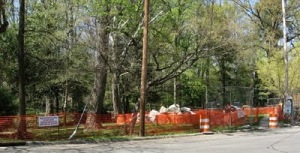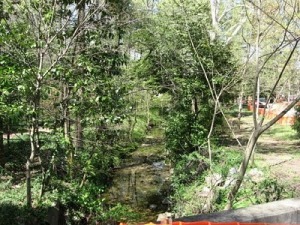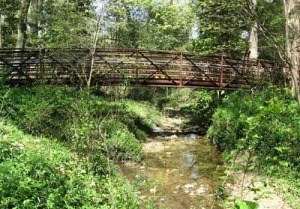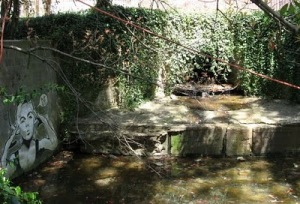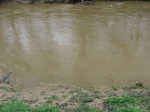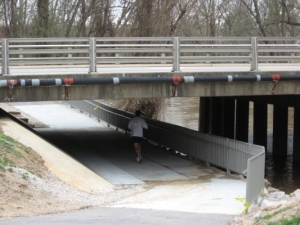The huge sewer project – seen above at Crabtree Boulevard looking toward the Mouth of Pigeon House Branch – has introduced a new geography to Raleigh Swamp, my name for the body of water off Raleigh Boulevard just north of its intersection with Crabtree Boulevard. The large wooden causeway and gazebo were wonderful additions to the meeting of Buckeye trail and Middle Crabtree Trail. Now the sewer project has dictated a large dam and concrete bridge section that bisects the “swamp.” I know a real swamp is moving water with trees, but this lowland was dotted with dying trees for years after its establishment, and the snags of many remain as resting spots for herons, cormorants, and the occasional wood duck. Canada geese and mallards breed here, while the turtle population has grown to a staggering level. It is all thanks to the beavers.
When I first returned to Raleigh from Greensboro in 1980, they were starting to build the Raleigh Boulevard bridge over Crabtree Creek. The caissons they used to sink the bridge piers were impressive, and Dulci, my black lab and I kept a close watch on the process. At this time, the “Raleigh Swamp” area was a sometime wetland dotted with scrub trees and ribboned with the paths of homeless campers. Like many floodplains in the area, it got wet in the winter but stayed dry most summers. The Boulevard project changed that, with a little help from the local beavers. The transition was clarified for me by a city engineer years later through a comment on this blog in 2009. I quote it in full below:
Was reading through your website after getting the link from the Fletcher Park Watergarden and noted that the “pond” off Raleigh Blvd was one of your favorite places. I thought I’d mention that this was actually a City of Raleigh mitigation project I designed many years ago to offset the environmental impacts from the construction of Raleigh Blvd. It was supposed to be a wetland but the beavers in the area had a different idea as they immediately blocked the culverts under the roadway causing the water to back up and form a permanent pond. Can’t say I object to the result of their efforts. It’s a beautiful spot and the addition of the greenway has made it accessible to the masses.
Mark Senior, PE, Senior Project Engineer, Water Quality Section, Stormwater Divsion of the City of Raleigh Public Works Department
The beavers have indeed made great use of the spot with several different lodges in different spots. New generations of beavers tend to build their own lodge. Until I got the info from Mark, I assumed the construction of the road bed dammed up the water. The water on the east side of Raleigh Boulevard acts more normally – rising and falling with rains and seasons. I know the beavers play over there as well, because you can see their slides into Crabtree Creek as you walk down Buckeye toward Rollingwood.
Getting back to the sewer project, you can see above the large dam across the wetland. This, along with the upgraded line in general, has changed the location and depth of water around the edges of the marsh (which is technically what it is). Some areas are now totally dry – at least for now – and some are substantially deeper. No real harm done, since nature and time effect these kinds of changes all the time anyway. but the newly dry areas, which were beaver playgrounds until now, will undergo an interesting and specialized kind of succession – new plants adapted to the new conditions will take over. It should be a fascinating transition and Raleigh Nature will keep an eye on it. Below are shots of the stranded areas.
The beavers had a lodge at the very spot pictured below years ago but abandoned it during the drought of the early 2000s. Perhaps they will rebuild now that the water situation is restored!









